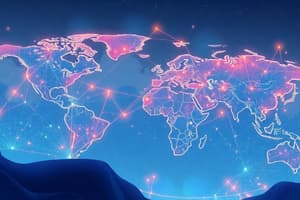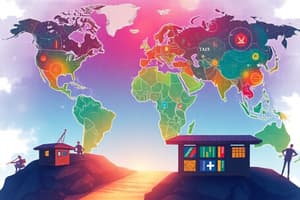Podcast
Questions and Answers
Which of the following best describes the concept of comparative advantage in the context of globalization?
Which of the following best describes the concept of comparative advantage in the context of globalization?
- Countries should aim to produce all goods domestically to reduce reliance on international trade.
- Countries should focus on exporting only luxury goods to maximize profits.
- Nations should specialize in producing goods and services that they can produce more efficiently relative to other nations. (correct)
- Nations should impose high tariffs on imports to protect domestic industries.
What is a primary criticism of the Washington Consensus approach to economic development?
What is a primary criticism of the Washington Consensus approach to economic development?
- It overemphasizes the role of state intervention in promoting economic stability.
- It neglects the importance of market-led strategies, privatization, and reduced trade restrictions.
- It suggests countries should develop first, then integrate, potentially hindering early growth. (correct)
- It advocates for protectionist policies that shield domestic industries from foreign competition.
In the context of the Growth-Poverty-Inequality (GPI) triangle, how does poverty potentially slow down economic growth?
In the context of the Growth-Poverty-Inequality (GPI) triangle, how does poverty potentially slow down economic growth?
- By limiting access to credit and investment opportunities for a significant portion of the population. (correct)
- By increasing overall levels of human capital and productivity.
- By promoting greater income equality, which reduces incentives for innovation and entrepreneurship.
- By encouraging higher savings rates among the poor, leading to decreased consumer spending.
Which of the following best describes the concept of 'weak sustainability'?
Which of the following best describes the concept of 'weak sustainability'?
According to Schumpeter's theory of 'creative destruction,' how does technological change impact economic growth?
According to Schumpeter's theory of 'creative destruction,' how does technological change impact economic growth?
How can digitalization potentially worsen inequality within developing countries?
How can digitalization potentially worsen inequality within developing countries?
What is a primary obstacle to rapid energy transitions from fossil fuels to renewable sources?
What is a primary obstacle to rapid energy transitions from fossil fuels to renewable sources?
How do higher temperatures resulting from climate change disproportionately affect economic growth in poorer countries?
How do higher temperatures resulting from climate change disproportionately affect economic growth in poorer countries?
According to Amartya Sen's Capability Approach, why are traditional measures of inequality (e.g., income) limited?
According to Amartya Sen's Capability Approach, why are traditional measures of inequality (e.g., income) limited?
Which of the following is NOT typically considered a form of capital that drives economic growth?
Which of the following is NOT typically considered a form of capital that drives economic growth?
How does social capital contribute to development?
How does social capital contribute to development?
Which trade strategy prioritizes domestic industrial growth before engaging in international trade?
Which trade strategy prioritizes domestic industrial growth before engaging in international trade?
How does Foreign Direct Investment (FDI) potentially harm local control within a developing country?
How does Foreign Direct Investment (FDI) potentially harm local control within a developing country?
What is the Kuznets Curve primarily used to illustrate?
What is the Kuznets Curve primarily used to illustrate?
What characterizes Kuznets' 'Modern Economic Growth'?
What characterizes Kuznets' 'Modern Economic Growth'?
Which of the following is the main challenge faced by developing countries concerning structural transformation?
Which of the following is the main challenge faced by developing countries concerning structural transformation?
Which of the following is an example of a digital platform facilitating development?
Which of the following is an example of a digital platform facilitating development?
Which factor does NOT contribute to the slowness of energy transitions?
Which factor does NOT contribute to the slowness of energy transitions?
What challenge does the EU face in its energy transition away from Russian fossil fuels?
What challenge does the EU face in its energy transition away from Russian fossil fuels?
According to Dell et al. (2008), how does climate change impact poorer countries?
According to Dell et al. (2008), how does climate change impact poorer countries?
What is the role of strong instiutions in social capital?
What is the role of strong instiutions in social capital?
What is NOT a policy implication to reduce capability inequality?
What is NOT a policy implication to reduce capability inequality?
How developed and developing countries reacted to climate change?
How developed and developing countries reacted to climate change?
Which of the following best describes the sequential nature of energy transitions?
Which of the following best describes the sequential nature of energy transitions?
Unlike physical capital, social capital...
Unlike physical capital, social capital...
Flashcards
Globalization
Globalization
Rapid expansion of global interactions and integration of countries.
Comparative Advantage
Comparative Advantage
Countries specialize in producing goods they produce most efficiently.
Import Substitution Industrialisation (ISI)
Import Substitution Industrialisation (ISI)
Strategy focused on limiting imports to nurture domestic industries.
Export-Led Industrialisation (ELI)
Export-Led Industrialisation (ELI)
Signup and view all the flashcards
Washington Consensus
Washington Consensus
Signup and view all the flashcards
Foreign Direct Investment (FDI)
Foreign Direct Investment (FDI)
Signup and view all the flashcards
Global Value Chains (GVCs)
Global Value Chains (GVCs)
Signup and view all the flashcards
Economic Growth
Economic Growth
Signup and view all the flashcards
Inequality
Inequality
Signup and view all the flashcards
Kuznets Curve
Kuznets Curve
Signup and view all the flashcards
Sustainable Development
Sustainable Development
Signup and view all the flashcards
Structural Transformation
Structural Transformation
Signup and view all the flashcards
Schumpeterian Creative Destruction
Schumpeterian Creative Destruction
Signup and view all the flashcards
Digitalization
Digitalization
Signup and view all the flashcards
Digital Platforms
Digital Platforms
Signup and view all the flashcards
Energy Transitions
Energy Transitions
Signup and view all the flashcards
Path Dependence (in energy)
Path Dependence (in energy)
Signup and view all the flashcards
Physical Capital
Physical Capital
Signup and view all the flashcards
Human Capital
Human Capital
Signup and view all the flashcards
Natural Capital
Natural Capital
Signup and view all the flashcards
Technological Knowledge
Technological Knowledge
Signup and view all the flashcards
Social Capital
Social Capital
Signup and view all the flashcards
Capability Approach
Capability Approach
Signup and view all the flashcards
Capabilities (Sen)
Capabilities (Sen)
Signup and view all the flashcards
Obstacles to Fast Energy Transitions
Obstacles to Fast Energy Transitions
Signup and view all the flashcards
Study Notes
- Rapid expansion of global interactions, integration of countries, reduction of transport/communication costs, and fewer trade barriers facilitate globalization.
- Globalization involves economic, cultural, and social aspects.
- Globalization can be measured by trade volumes, tariffs, outsourcing, and FDI.
Historical Perspective
- Globalization began with luxury trade in the 1500s.
- Globalization accelerated in the 19th century with trade in basic goods such as wheat and textiles.
Comparative Advantage
- Nations specialize in producing goods they can produce more efficiently.
International Trade
- International trade fosters growth, welfare, and technological transfer.
- It can also cause volatility, inequality, and biased negotiations against poor countries.
Trade Strategies
- Import Substitution Industrialisation (ISI) and Export-Led Industrialisation (ELI) are trade strategies.
- Countries with outward-oriented strategies grow faster, according to Kruger in 1998.
- Economic liberalization generally boosts income growth.
- Integration should follow development, not precede it (Rodrik, 2001).
Washington Consensus
- Market-led theory emphasizing economic openness, privatization, and reducing trade restrictions.
Foreign Direct Investment (FDI)
- FDI is important for investment, technology transfer, and integration.
- FDI can harm local control and create environmental damage.
Global Value Chains (GVCs)
- Offshoring of low-skilled work to low-wage countries takes place within GVCs.
- Developing economies are now more integrated but face inequality issues.
Growth, Income Distribution & Sustainable Development
Economic Growth
- Increase in goods/services production over time, often measured by GDP.
Kuznets' Modern Economic Growth
- High growth rates, productivity increase, structural transformation, urbanization, and technological innovation.
Inequality
- Inequality of opportunity vs. inequality of outcome.
- The Gini Index measures inequality.
Growth-Poverty-Inequality (GPI) Triangle (Bourguignon, 2004)
- Growth reduces poverty but does not necessarily reduce inequality.
- Poverty can slow growth, especially with credit market imperfections.
Kuznets Curve
- Inequality rises with growth initially, then declines as economies develop.
Inequality and Growth
- Excessive inequality shortens growth spells (Berg & Ostry, 2010).
Climate Change & Economic Growth
- Developing countries are more vulnerable to climate change.
- Higher temperatures reduce economic growth, especially in poor countries.
Sustainable Development
- Development that meets present needs without compromising future generations. (Brundtland Commission)
Weak vs. Strong Sustainability
- Whether natural capital can be substituted by manufactured capital.
Technological Change, Digitalisation, and Development
Structural Transformation
- Shift from agriculture to industry and services, with urbanization and declining agricultural labor.
- Developing countries face unique challenges compared to historical transformations of developed countries.
Technological Change
- Schumpeterian creative destruction: Radical innovations create growth waves but also destroy outdated industries.
- Growth is non-linear; technological paradigms shape economic performance over time.
Digitalization
- Widespread adoption of digital technologies, including broadband, cloud computing, and mobile telephony.
- Digitalization promotes efficiency, education, healthcare, governance, and trade.
- It also creates inequality due to skill biases.
Digital Platforms & Development
- Digital platforms facilitate interaction between distant entities.
- They improve access to markets and provide new opportunities for development.
- Developing countries face challenges due to limited infrastructure and human capital.
Digitalisation and Structural Change
- Digitalization can boost productivity.
- However, it may worsen inequality if technological access is unequal.
Energy Transitions & Social Capabilities
Energy Transitions
- Shifts in primary energy sources, e.g., from coal to renewables
- Critical for sustainable development and climate change mitigation
Key Obstacles to Fast Transitions
- Transitions happen in phases rather than simultaneously.
- Investments in fossil fuels slow the shift.
- Wind and solar require backup due to intermittency.
- Replacing fossil fuels is easier in electricity than in transport or industries such as cement and iron.
Global & European Context
- The EU's push to reduce dependence on Russian energy results in complex restructuring & market shifts.
- Developing nations struggle with high clean energy costs.
Climate Change & Economic Growth (Dell et al., 2008)
- Higher temperatures negatively impact economic growth, especially in poorer countries.
- Climate change could worsen inequality.
Social Capabilities & Inequality
Forms of Capital & Economic Growth
- Physical (infrastructure, investments).
- Human (education, skills).
- Social (trust, networks).
- Natural (resources).
- Technological knowledge (innovation).
Social Capital & Development
- Social capital facilitates cooperation and reduces transaction costs.
- Social capital works through networks, trust, and institutions.
- Social capital cannot be bought; it requires time to build.
Inequality & The Capability Approach (Sen, 1993)
- Measures what people can do and be, not just income.
- Capability gaps between rich and poor impact freedoms and opportunities.
Reducing Capability Inequality
- Expand quality education and healthcare.
- Strengthen political & social inclusion.
- Address gender inequality.
Energy Transitions
Key Concepts
- Energy transition is a shift from one dominant energy system to another (e.g., from coal to renewables).
- Energy transition is crucial for reducing carbon emissions and ensuring sustainable development.
- Economic, political, technological, and infrastructure limitations slow down energy transitions.
Why Do Energy Transitions Take Time? (Smil, 2016; Sovacool, 2016)
- Energy transitions happen in phases rather than all at once.
- Existing energy systems (fossil fuels) are deeply embedded in economies; this is called path dependence.
- Infrastructure changes require significant investment leading to high initial costs.
- Renewables (solar/wind) need backup energy storage because of intermittency issues.
Global & European Challenges
- EU policy shift involves moving away from Russian fossil fuels, resulting in restructuring of energy systems and market instability.
- Competing for liquefied natural gas (LNG) with Global South countries causes higher energy prices.
- Developing nations often rely on cheap, fossil-based energy.
- There is a lack of infrastructure for rapid renewable adoption.
- Climate change impacts (Dell et al., 2008) reduce growth potential.
Impact of Climate Change on Economic Growth (Dell et al., 2008)
- Higher temperatures cause economic slowdown, especially in poor countries.
- Climate change leads to increased political instability in affected regions.
- Climate shocks can lower growth rates rather than just reducing output.
Social Capabilities & Inequality
Forms of Capital & Their Role in Development
- Physical Capital: Infrastructure, real estate, financial assets.
- Human Capital: Education, skills, and experience that increase productivity.
- Natural Capital: Renewable & non-renewable resources.
- Technological Knowledge: Innovations improving production methods.
- Social Capital (Putnam, 1993): Networks, trust, norms that enhance cooperation.
Social Capital – Why It Matters
- Social capital helps societies function efficiently through trust and cooperation.
- Unlike physical capital, it cannot be bought; social cpital must be built over time.
- Strong institutions can enhance social capital, while corruption weakens it.
- Social capital impacts development, as seen in successful grassroots movements.
The Capability Approach (Amartya Sen, 1993)
- Traditional measures of inequality (income, wealth) are limited.
- Capabilities = What people are actually able to do and be (e.g., access to education, healthcare). Developmental focus should be on expanding real freedoms, not just economic growth.
Key Inequality Concerns
- Gaps between "capability-rich" and "capability-poor" create lasting disadvantages.
Income vs. capability inequality
- Two people may have the same income but vastly different access to opportunities.
- For example, a disabled person with a high income still faces mobility barriers.
Policy Implications
- There is a need to expand education & healthcare access.
- Promote political inclusion and gender equality.
Studying That Suits You
Use AI to generate personalized quizzes and flashcards to suit your learning preferences.




